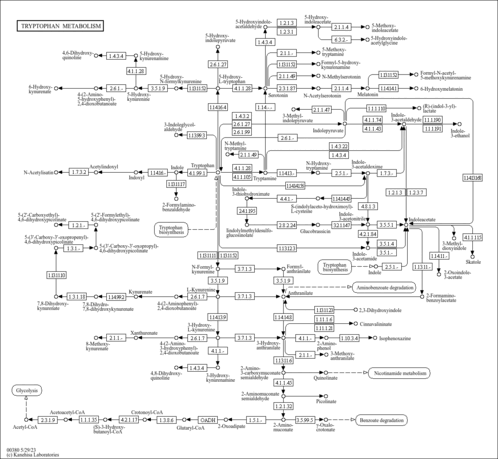| 5-Hydroxyindoleacetaldehyde,1TMS,isomer #1 | C[Si](C)(C)OC1=CC=C2[NH]C=C(CC=O)C2=C1 | 2043.9 | Semi standard non polar | 33892256 |
| 5-Hydroxyindoleacetaldehyde,1TMS,isomer #2 | C[Si](C)(C)OC=CC1=C[NH]C2=CC=C(O)C=C12 | 2233.3 | Semi standard non polar | 33892256 |
| 5-Hydroxyindoleacetaldehyde,1TMS,isomer #3 | C[Si](C)(C)N1C=C(CC=O)C2=CC(O)=CC=C21 | 2066.6 | Semi standard non polar | 33892256 |
| 5-Hydroxyindoleacetaldehyde,2TMS,isomer #1 | C[Si](C)(C)OC=CC1=C[NH]C2=CC=C(O[Si](C)(C)C)C=C12 | 2284.5 | Semi standard non polar | 33892256 |
| 5-Hydroxyindoleacetaldehyde,2TMS,isomer #1 | C[Si](C)(C)OC=CC1=C[NH]C2=CC=C(O[Si](C)(C)C)C=C12 | 2171.1 | Standard non polar | 33892256 |
| 5-Hydroxyindoleacetaldehyde,2TMS,isomer #1 | C[Si](C)(C)OC=CC1=C[NH]C2=CC=C(O[Si](C)(C)C)C=C12 | 2415.6 | Standard polar | 33892256 |
| 5-Hydroxyindoleacetaldehyde,2TMS,isomer #2 | C[Si](C)(C)OC1=CC=C2C(=C1)C(CC=O)=CN2[Si](C)(C)C | 2071.3 | Semi standard non polar | 33892256 |
| 5-Hydroxyindoleacetaldehyde,2TMS,isomer #2 | C[Si](C)(C)OC1=CC=C2C(=C1)C(CC=O)=CN2[Si](C)(C)C | 2059.1 | Standard non polar | 33892256 |
| 5-Hydroxyindoleacetaldehyde,2TMS,isomer #2 | C[Si](C)(C)OC1=CC=C2C(=C1)C(CC=O)=CN2[Si](C)(C)C | 2192.4 | Standard polar | 33892256 |
| 5-Hydroxyindoleacetaldehyde,2TMS,isomer #3 | C[Si](C)(C)OC=CC1=CN([Si](C)(C)C)C2=CC=C(O)C=C12 | 2325.3 | Semi standard non polar | 33892256 |
| 5-Hydroxyindoleacetaldehyde,2TMS,isomer #3 | C[Si](C)(C)OC=CC1=CN([Si](C)(C)C)C2=CC=C(O)C=C12 | 2350.5 | Standard non polar | 33892256 |
| 5-Hydroxyindoleacetaldehyde,2TMS,isomer #3 | C[Si](C)(C)OC=CC1=CN([Si](C)(C)C)C2=CC=C(O)C=C12 | 2389.3 | Standard polar | 33892256 |
| 5-Hydroxyindoleacetaldehyde,3TMS,isomer #1 | C[Si](C)(C)OC=CC1=CN([Si](C)(C)C)C2=CC=C(O[Si](C)(C)C)C=C12 | 2310.8 | Semi standard non polar | 33892256 |
| 5-Hydroxyindoleacetaldehyde,3TMS,isomer #1 | C[Si](C)(C)OC=CC1=CN([Si](C)(C)C)C2=CC=C(O[Si](C)(C)C)C=C12 | 2344.5 | Standard non polar | 33892256 |
| 5-Hydroxyindoleacetaldehyde,3TMS,isomer #1 | C[Si](C)(C)OC=CC1=CN([Si](C)(C)C)C2=CC=C(O[Si](C)(C)C)C=C12 | 2253.1 | Standard polar | 33892256 |
| 5-Hydroxyindoleacetaldehyde,1TBDMS,isomer #1 | CC(C)(C)[Si](C)(C)OC1=CC=C2[NH]C=C(CC=O)C2=C1 | 2312.0 | Semi standard non polar | 33892256 |
| 5-Hydroxyindoleacetaldehyde,1TBDMS,isomer #2 | CC(C)(C)[Si](C)(C)OC=CC1=C[NH]C2=CC=C(O)C=C12 | 2476.4 | Semi standard non polar | 33892256 |
| 5-Hydroxyindoleacetaldehyde,1TBDMS,isomer #3 | CC(C)(C)[Si](C)(C)N1C=C(CC=O)C2=CC(O)=CC=C21 | 2318.3 | Semi standard non polar | 33892256 |
| 5-Hydroxyindoleacetaldehyde,2TBDMS,isomer #1 | CC(C)(C)[Si](C)(C)OC=CC1=C[NH]C2=CC=C(O[Si](C)(C)C(C)(C)C)C=C12 | 2766.1 | Semi standard non polar | 33892256 |
| 5-Hydroxyindoleacetaldehyde,2TBDMS,isomer #1 | CC(C)(C)[Si](C)(C)OC=CC1=C[NH]C2=CC=C(O[Si](C)(C)C(C)(C)C)C=C12 | 2606.4 | Standard non polar | 33892256 |
| 5-Hydroxyindoleacetaldehyde,2TBDMS,isomer #1 | CC(C)(C)[Si](C)(C)OC=CC1=C[NH]C2=CC=C(O[Si](C)(C)C(C)(C)C)C=C12 | 2611.5 | Standard polar | 33892256 |
| 5-Hydroxyindoleacetaldehyde,2TBDMS,isomer #2 | CC(C)(C)[Si](C)(C)OC1=CC=C2C(=C1)C(CC=O)=CN2[Si](C)(C)C(C)(C)C | 2545.0 | Semi standard non polar | 33892256 |
| 5-Hydroxyindoleacetaldehyde,2TBDMS,isomer #2 | CC(C)(C)[Si](C)(C)OC1=CC=C2C(=C1)C(CC=O)=CN2[Si](C)(C)C(C)(C)C | 2479.6 | Standard non polar | 33892256 |
| 5-Hydroxyindoleacetaldehyde,2TBDMS,isomer #2 | CC(C)(C)[Si](C)(C)OC1=CC=C2C(=C1)C(CC=O)=CN2[Si](C)(C)C(C)(C)C | 2385.9 | Standard polar | 33892256 |
| 5-Hydroxyindoleacetaldehyde,2TBDMS,isomer #3 | CC(C)(C)[Si](C)(C)OC=CC1=CN([Si](C)(C)C(C)(C)C)C2=CC=C(O)C=C12 | 2766.7 | Semi standard non polar | 33892256 |
| 5-Hydroxyindoleacetaldehyde,2TBDMS,isomer #3 | CC(C)(C)[Si](C)(C)OC=CC1=CN([Si](C)(C)C(C)(C)C)C2=CC=C(O)C=C12 | 2741.8 | Standard non polar | 33892256 |
| 5-Hydroxyindoleacetaldehyde,2TBDMS,isomer #3 | CC(C)(C)[Si](C)(C)OC=CC1=CN([Si](C)(C)C(C)(C)C)C2=CC=C(O)C=C12 | 2550.1 | Standard polar | 33892256 |
| 5-Hydroxyindoleacetaldehyde,3TBDMS,isomer #1 | CC(C)(C)[Si](C)(C)OC=CC1=CN([Si](C)(C)C(C)(C)C)C2=CC=C(O[Si](C)(C)C(C)(C)C)C=C12 | 2968.3 | Semi standard non polar | 33892256 |
| 5-Hydroxyindoleacetaldehyde,3TBDMS,isomer #1 | CC(C)(C)[Si](C)(C)OC=CC1=CN([Si](C)(C)C(C)(C)C)C2=CC=C(O[Si](C)(C)C(C)(C)C)C=C12 | 2929.1 | Standard non polar | 33892256 |
| 5-Hydroxyindoleacetaldehyde,3TBDMS,isomer #1 | CC(C)(C)[Si](C)(C)OC=CC1=CN([Si](C)(C)C(C)(C)C)C2=CC=C(O[Si](C)(C)C(C)(C)C)C=C12 | 2532.4 | Standard polar | 33892256 |
